Business Strategy Report: Toyota's Strategic Management Plan
VerifiedAdded on 2021/02/21
|8
|2548
|493
Report
AI Summary
This report provides a comprehensive analysis of Toyota's business strategy, focusing on its application of Porter's Five Forces model to evaluate competition within the automotive market. It delves into the threat of new entrants, the power of suppliers and customers, the threat of substitutes, and the existing competition within the industry. The report then explores strategies to improve Toyota's competitive edge and market position, including innovative and cost leadership strategies. Furthermore, it applies models such as the Ansoff Matrix, particularly focusing on market penetration, product development, market development, and diversification strategies to formulate a strategic management plan. The plan includes Toyota's vision, mission, objectives, and tactics, emphasizing product development as a key strategy for expanding market share and increasing customer satisfaction in the face of intense competition. The report concludes that effective strategies are essential for achieving business objectives and emphasizes the importance of adapting to the ever-changing market dynamics.

Business Strategy
Paraphrase This Document
Need a fresh take? Get an instant paraphrase of this document with our AI Paraphraser

Table of Contents
P3. Application of Porter's Five Forces model for evaluating competition in market...........1
M3. Devise appropriate strategies to improve competitive edge and market position..........3
P4. & M4. Application of models, theories and concepts for forming better understanding and
interpretation and strategic management plan........................................................................3
CONCLUSION................................................................................................................................5
REFERENCES................................................................................................................................6
P3. Application of Porter's Five Forces model for evaluating competition in market...........1
M3. Devise appropriate strategies to improve competitive edge and market position..........3
P4. & M4. Application of models, theories and concepts for forming better understanding and
interpretation and strategic management plan........................................................................3
CONCLUSION................................................................................................................................5
REFERENCES................................................................................................................................6
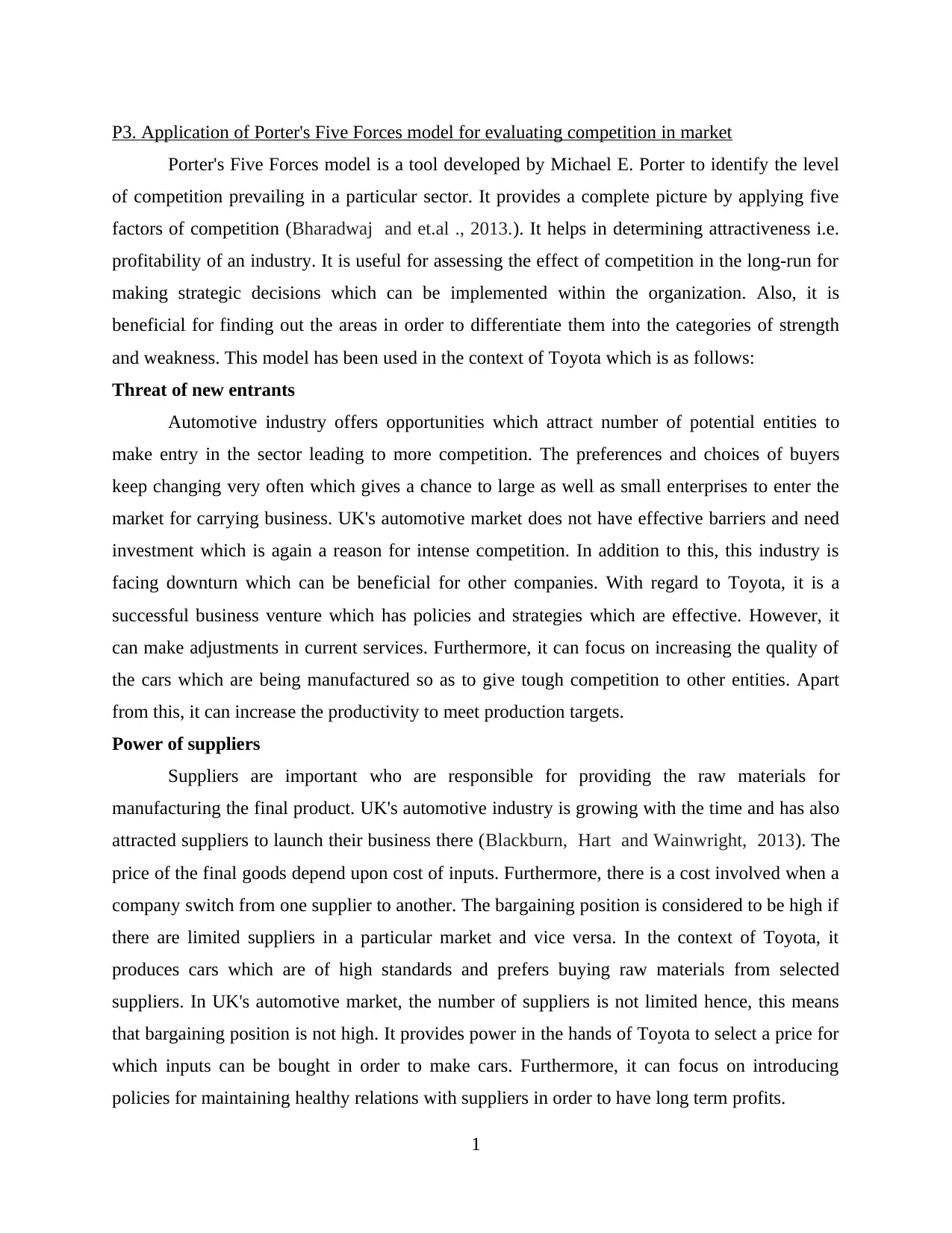
P3. Application of Porter's Five Forces model for evaluating competition in market
Porter's Five Forces model is a tool developed by Michael E. Porter to identify the level
of competition prevailing in a particular sector. It provides a complete picture by applying five
factors of competition (Bharadwaj and et.al ., 2013.). It helps in determining attractiveness i.e.
profitability of an industry. It is useful for assessing the effect of competition in the long-run for
making strategic decisions which can be implemented within the organization. Also, it is
beneficial for finding out the areas in order to differentiate them into the categories of strength
and weakness. This model has been used in the context of Toyota which is as follows:
Threat of new entrants
Automotive industry offers opportunities which attract number of potential entities to
make entry in the sector leading to more competition. The preferences and choices of buyers
keep changing very often which gives a chance to large as well as small enterprises to enter the
market for carrying business. UK's automotive market does not have effective barriers and need
investment which is again a reason for intense competition. In addition to this, this industry is
facing downturn which can be beneficial for other companies. With regard to Toyota, it is a
successful business venture which has policies and strategies which are effective. However, it
can make adjustments in current services. Furthermore, it can focus on increasing the quality of
the cars which are being manufactured so as to give tough competition to other entities. Apart
from this, it can increase the productivity to meet production targets.
Power of suppliers
Suppliers are important who are responsible for providing the raw materials for
manufacturing the final product. UK's automotive industry is growing with the time and has also
attracted suppliers to launch their business there (Blackburn, Hart and Wainwright, 2013). The
price of the final goods depend upon cost of inputs. Furthermore, there is a cost involved when a
company switch from one supplier to another. The bargaining position is considered to be high if
there are limited suppliers in a particular market and vice versa. In the context of Toyota, it
produces cars which are of high standards and prefers buying raw materials from selected
suppliers. In UK's automotive market, the number of suppliers is not limited hence, this means
that bargaining position is not high. It provides power in the hands of Toyota to select a price for
which inputs can be bought in order to make cars. Furthermore, it can focus on introducing
policies for maintaining healthy relations with suppliers in order to have long term profits.
1
Porter's Five Forces model is a tool developed by Michael E. Porter to identify the level
of competition prevailing in a particular sector. It provides a complete picture by applying five
factors of competition (Bharadwaj and et.al ., 2013.). It helps in determining attractiveness i.e.
profitability of an industry. It is useful for assessing the effect of competition in the long-run for
making strategic decisions which can be implemented within the organization. Also, it is
beneficial for finding out the areas in order to differentiate them into the categories of strength
and weakness. This model has been used in the context of Toyota which is as follows:
Threat of new entrants
Automotive industry offers opportunities which attract number of potential entities to
make entry in the sector leading to more competition. The preferences and choices of buyers
keep changing very often which gives a chance to large as well as small enterprises to enter the
market for carrying business. UK's automotive market does not have effective barriers and need
investment which is again a reason for intense competition. In addition to this, this industry is
facing downturn which can be beneficial for other companies. With regard to Toyota, it is a
successful business venture which has policies and strategies which are effective. However, it
can make adjustments in current services. Furthermore, it can focus on increasing the quality of
the cars which are being manufactured so as to give tough competition to other entities. Apart
from this, it can increase the productivity to meet production targets.
Power of suppliers
Suppliers are important who are responsible for providing the raw materials for
manufacturing the final product. UK's automotive industry is growing with the time and has also
attracted suppliers to launch their business there (Blackburn, Hart and Wainwright, 2013). The
price of the final goods depend upon cost of inputs. Furthermore, there is a cost involved when a
company switch from one supplier to another. The bargaining position is considered to be high if
there are limited suppliers in a particular market and vice versa. In the context of Toyota, it
produces cars which are of high standards and prefers buying raw materials from selected
suppliers. In UK's automotive market, the number of suppliers is not limited hence, this means
that bargaining position is not high. It provides power in the hands of Toyota to select a price for
which inputs can be bought in order to make cars. Furthermore, it can focus on introducing
policies for maintaining healthy relations with suppliers in order to have long term profits.
1
⊘ This is a preview!⊘
Do you want full access?
Subscribe today to unlock all pages.

Trusted by 1+ million students worldwide
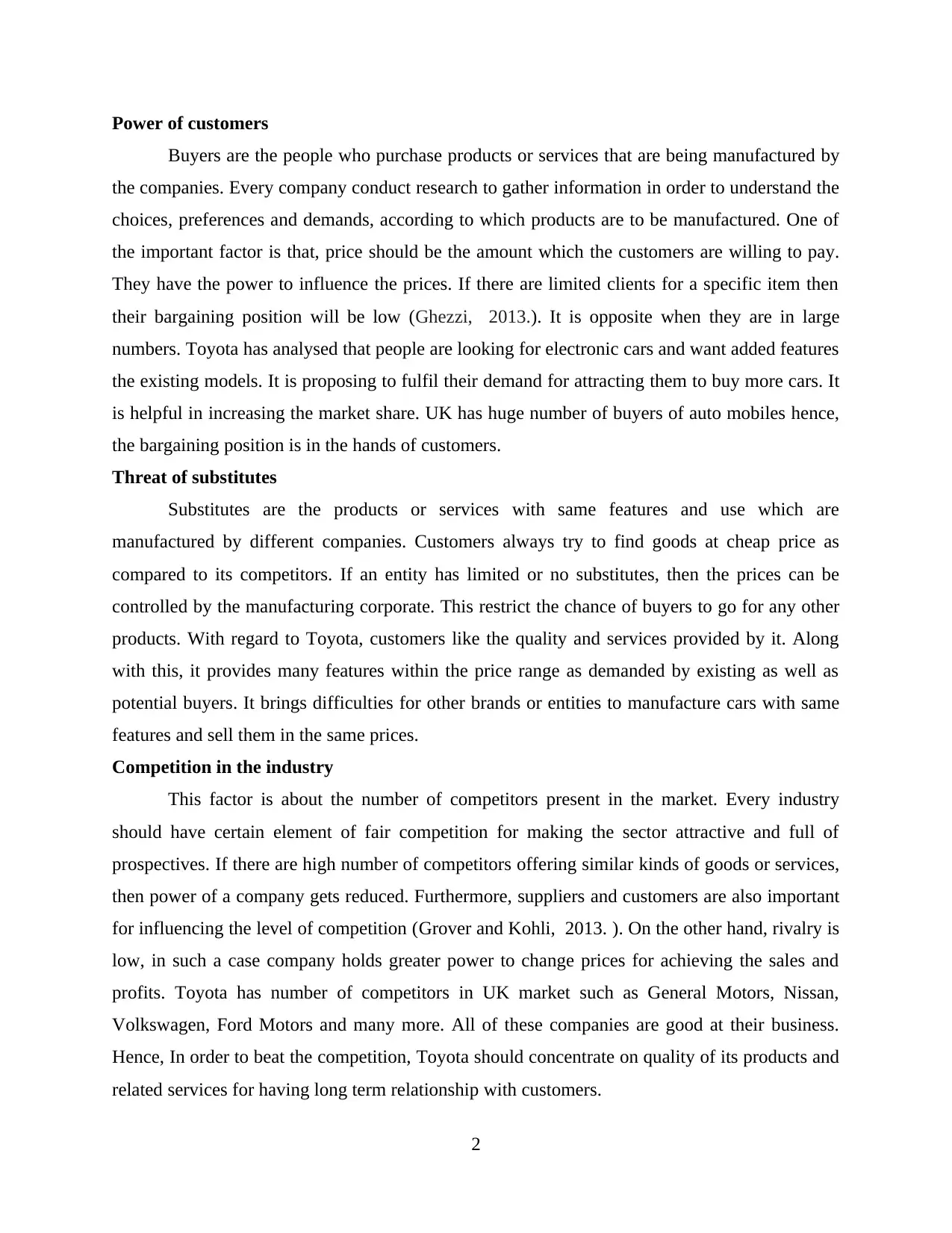
Power of customers
Buyers are the people who purchase products or services that are being manufactured by
the companies. Every company conduct research to gather information in order to understand the
choices, preferences and demands, according to which products are to be manufactured. One of
the important factor is that, price should be the amount which the customers are willing to pay.
They have the power to influence the prices. If there are limited clients for a specific item then
their bargaining position will be low (Ghezzi, 2013.). It is opposite when they are in large
numbers. Toyota has analysed that people are looking for electronic cars and want added features
the existing models. It is proposing to fulfil their demand for attracting them to buy more cars. It
is helpful in increasing the market share. UK has huge number of buyers of auto mobiles hence,
the bargaining position is in the hands of customers.
Threat of substitutes
Substitutes are the products or services with same features and use which are
manufactured by different companies. Customers always try to find goods at cheap price as
compared to its competitors. If an entity has limited or no substitutes, then the prices can be
controlled by the manufacturing corporate. This restrict the chance of buyers to go for any other
products. With regard to Toyota, customers like the quality and services provided by it. Along
with this, it provides many features within the price range as demanded by existing as well as
potential buyers. It brings difficulties for other brands or entities to manufacture cars with same
features and sell them in the same prices.
Competition in the industry
This factor is about the number of competitors present in the market. Every industry
should have certain element of fair competition for making the sector attractive and full of
prospectives. If there are high number of competitors offering similar kinds of goods or services,
then power of a company gets reduced. Furthermore, suppliers and customers are also important
for influencing the level of competition (Grover and Kohli, 2013. ). On the other hand, rivalry is
low, in such a case company holds greater power to change prices for achieving the sales and
profits. Toyota has number of competitors in UK market such as General Motors, Nissan,
Volkswagen, Ford Motors and many more. All of these companies are good at their business.
Hence, In order to beat the competition, Toyota should concentrate on quality of its products and
related services for having long term relationship with customers.
2
Buyers are the people who purchase products or services that are being manufactured by
the companies. Every company conduct research to gather information in order to understand the
choices, preferences and demands, according to which products are to be manufactured. One of
the important factor is that, price should be the amount which the customers are willing to pay.
They have the power to influence the prices. If there are limited clients for a specific item then
their bargaining position will be low (Ghezzi, 2013.). It is opposite when they are in large
numbers. Toyota has analysed that people are looking for electronic cars and want added features
the existing models. It is proposing to fulfil their demand for attracting them to buy more cars. It
is helpful in increasing the market share. UK has huge number of buyers of auto mobiles hence,
the bargaining position is in the hands of customers.
Threat of substitutes
Substitutes are the products or services with same features and use which are
manufactured by different companies. Customers always try to find goods at cheap price as
compared to its competitors. If an entity has limited or no substitutes, then the prices can be
controlled by the manufacturing corporate. This restrict the chance of buyers to go for any other
products. With regard to Toyota, customers like the quality and services provided by it. Along
with this, it provides many features within the price range as demanded by existing as well as
potential buyers. It brings difficulties for other brands or entities to manufacture cars with same
features and sell them in the same prices.
Competition in the industry
This factor is about the number of competitors present in the market. Every industry
should have certain element of fair competition for making the sector attractive and full of
prospectives. If there are high number of competitors offering similar kinds of goods or services,
then power of a company gets reduced. Furthermore, suppliers and customers are also important
for influencing the level of competition (Grover and Kohli, 2013. ). On the other hand, rivalry is
low, in such a case company holds greater power to change prices for achieving the sales and
profits. Toyota has number of competitors in UK market such as General Motors, Nissan,
Volkswagen, Ford Motors and many more. All of these companies are good at their business.
Hence, In order to beat the competition, Toyota should concentrate on quality of its products and
related services for having long term relationship with customers.
2
Paraphrase This Document
Need a fresh take? Get an instant paraphrase of this document with our AI Paraphraser
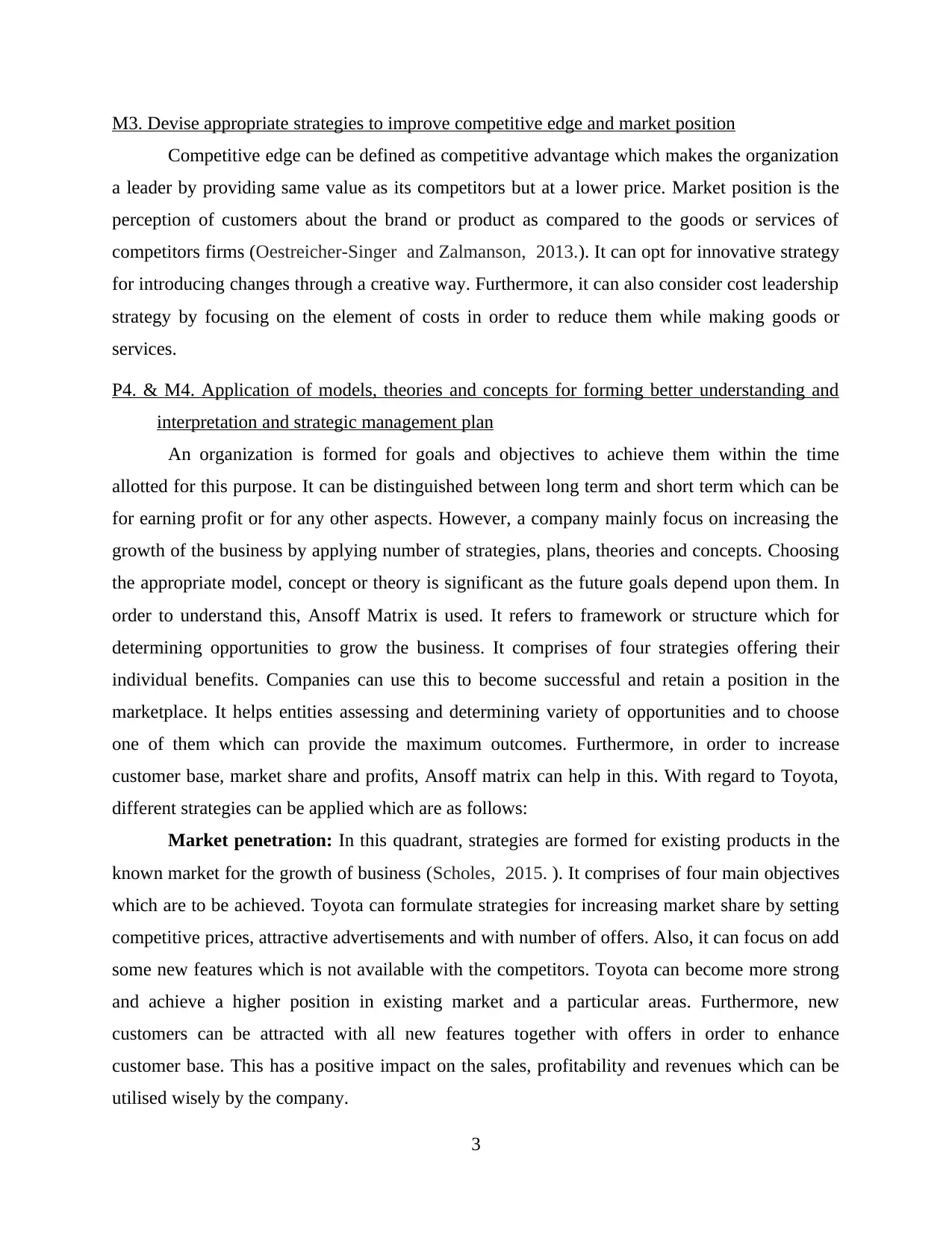
M3. Devise appropriate strategies to improve competitive edge and market position
Competitive edge can be defined as competitive advantage which makes the organization
a leader by providing same value as its competitors but at a lower price. Market position is the
perception of customers about the brand or product as compared to the goods or services of
competitors firms (Oestreicher-Singer and Zalmanson, 2013.). It can opt for innovative strategy
for introducing changes through a creative way. Furthermore, it can also consider cost leadership
strategy by focusing on the element of costs in order to reduce them while making goods or
services.
P4. & M4. Application of models, theories and concepts for forming better understanding and
interpretation and strategic management plan
An organization is formed for goals and objectives to achieve them within the time
allotted for this purpose. It can be distinguished between long term and short term which can be
for earning profit or for any other aspects. However, a company mainly focus on increasing the
growth of the business by applying number of strategies, plans, theories and concepts. Choosing
the appropriate model, concept or theory is significant as the future goals depend upon them. In
order to understand this, Ansoff Matrix is used. It refers to framework or structure which for
determining opportunities to grow the business. It comprises of four strategies offering their
individual benefits. Companies can use this to become successful and retain a position in the
marketplace. It helps entities assessing and determining variety of opportunities and to choose
one of them which can provide the maximum outcomes. Furthermore, in order to increase
customer base, market share and profits, Ansoff matrix can help in this. With regard to Toyota,
different strategies can be applied which are as follows:
Market penetration: In this quadrant, strategies are formed for existing products in the
known market for the growth of business (Scholes, 2015. ). It comprises of four main objectives
which are to be achieved. Toyota can formulate strategies for increasing market share by setting
competitive prices, attractive advertisements and with number of offers. Also, it can focus on add
some new features which is not available with the competitors. Toyota can become more strong
and achieve a higher position in existing market and a particular areas. Furthermore, new
customers can be attracted with all new features together with offers in order to enhance
customer base. This has a positive impact on the sales, profitability and revenues which can be
utilised wisely by the company.
3
Competitive edge can be defined as competitive advantage which makes the organization
a leader by providing same value as its competitors but at a lower price. Market position is the
perception of customers about the brand or product as compared to the goods or services of
competitors firms (Oestreicher-Singer and Zalmanson, 2013.). It can opt for innovative strategy
for introducing changes through a creative way. Furthermore, it can also consider cost leadership
strategy by focusing on the element of costs in order to reduce them while making goods or
services.
P4. & M4. Application of models, theories and concepts for forming better understanding and
interpretation and strategic management plan
An organization is formed for goals and objectives to achieve them within the time
allotted for this purpose. It can be distinguished between long term and short term which can be
for earning profit or for any other aspects. However, a company mainly focus on increasing the
growth of the business by applying number of strategies, plans, theories and concepts. Choosing
the appropriate model, concept or theory is significant as the future goals depend upon them. In
order to understand this, Ansoff Matrix is used. It refers to framework or structure which for
determining opportunities to grow the business. It comprises of four strategies offering their
individual benefits. Companies can use this to become successful and retain a position in the
marketplace. It helps entities assessing and determining variety of opportunities and to choose
one of them which can provide the maximum outcomes. Furthermore, in order to increase
customer base, market share and profits, Ansoff matrix can help in this. With regard to Toyota,
different strategies can be applied which are as follows:
Market penetration: In this quadrant, strategies are formed for existing products in the
known market for the growth of business (Scholes, 2015. ). It comprises of four main objectives
which are to be achieved. Toyota can formulate strategies for increasing market share by setting
competitive prices, attractive advertisements and with number of offers. Also, it can focus on add
some new features which is not available with the competitors. Toyota can become more strong
and achieve a higher position in existing market and a particular areas. Furthermore, new
customers can be attracted with all new features together with offers in order to enhance
customer base. This has a positive impact on the sales, profitability and revenues which can be
utilised wisely by the company.
3
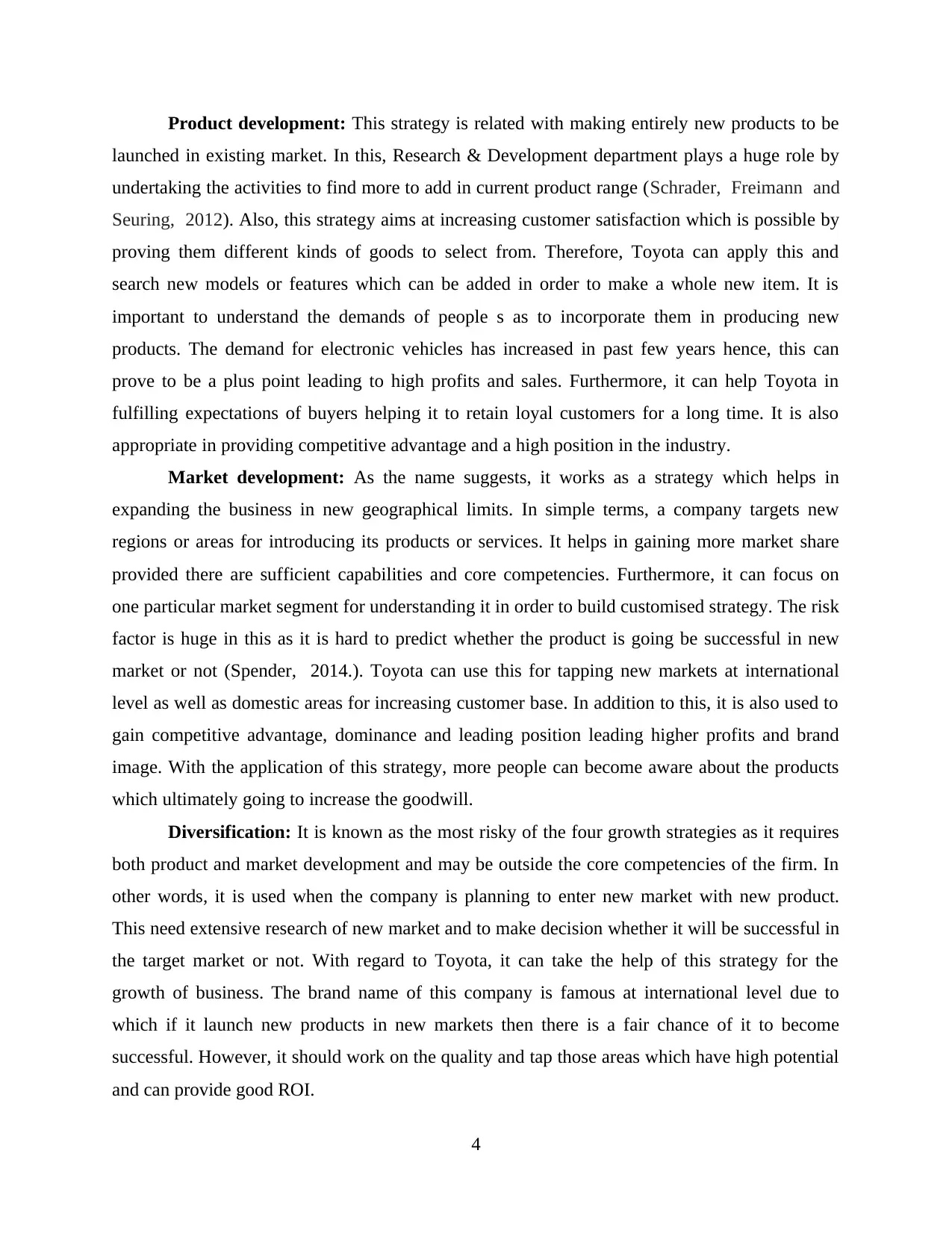
Product development: This strategy is related with making entirely new products to be
launched in existing market. In this, Research & Development department plays a huge role by
undertaking the activities to find more to add in current product range (Schrader, Freimann and
Seuring, 2012). Also, this strategy aims at increasing customer satisfaction which is possible by
proving them different kinds of goods to select from. Therefore, Toyota can apply this and
search new models or features which can be added in order to make a whole new item. It is
important to understand the demands of people s as to incorporate them in producing new
products. The demand for electronic vehicles has increased in past few years hence, this can
prove to be a plus point leading to high profits and sales. Furthermore, it can help Toyota in
fulfilling expectations of buyers helping it to retain loyal customers for a long time. It is also
appropriate in providing competitive advantage and a high position in the industry.
Market development: As the name suggests, it works as a strategy which helps in
expanding the business in new geographical limits. In simple terms, a company targets new
regions or areas for introducing its products or services. It helps in gaining more market share
provided there are sufficient capabilities and core competencies. Furthermore, it can focus on
one particular market segment for understanding it in order to build customised strategy. The risk
factor is huge in this as it is hard to predict whether the product is going be successful in new
market or not (Spender, 2014.). Toyota can use this for tapping new markets at international
level as well as domestic areas for increasing customer base. In addition to this, it is also used to
gain competitive advantage, dominance and leading position leading higher profits and brand
image. With the application of this strategy, more people can become aware about the products
which ultimately going to increase the goodwill.
Diversification: It is known as the most risky of the four growth strategies as it requires
both product and market development and may be outside the core competencies of the firm. In
other words, it is used when the company is planning to enter new market with new product.
This need extensive research of new market and to make decision whether it will be successful in
the target market or not. With regard to Toyota, it can take the help of this strategy for the
growth of business. The brand name of this company is famous at international level due to
which if it launch new products in new markets then there is a fair chance of it to become
successful. However, it should work on the quality and tap those areas which have high potential
and can provide good ROI.
4
launched in existing market. In this, Research & Development department plays a huge role by
undertaking the activities to find more to add in current product range (Schrader, Freimann and
Seuring, 2012). Also, this strategy aims at increasing customer satisfaction which is possible by
proving them different kinds of goods to select from. Therefore, Toyota can apply this and
search new models or features which can be added in order to make a whole new item. It is
important to understand the demands of people s as to incorporate them in producing new
products. The demand for electronic vehicles has increased in past few years hence, this can
prove to be a plus point leading to high profits and sales. Furthermore, it can help Toyota in
fulfilling expectations of buyers helping it to retain loyal customers for a long time. It is also
appropriate in providing competitive advantage and a high position in the industry.
Market development: As the name suggests, it works as a strategy which helps in
expanding the business in new geographical limits. In simple terms, a company targets new
regions or areas for introducing its products or services. It helps in gaining more market share
provided there are sufficient capabilities and core competencies. Furthermore, it can focus on
one particular market segment for understanding it in order to build customised strategy. The risk
factor is huge in this as it is hard to predict whether the product is going be successful in new
market or not (Spender, 2014.). Toyota can use this for tapping new markets at international
level as well as domestic areas for increasing customer base. In addition to this, it is also used to
gain competitive advantage, dominance and leading position leading higher profits and brand
image. With the application of this strategy, more people can become aware about the products
which ultimately going to increase the goodwill.
Diversification: It is known as the most risky of the four growth strategies as it requires
both product and market development and may be outside the core competencies of the firm. In
other words, it is used when the company is planning to enter new market with new product.
This need extensive research of new market and to make decision whether it will be successful in
the target market or not. With regard to Toyota, it can take the help of this strategy for the
growth of business. The brand name of this company is famous at international level due to
which if it launch new products in new markets then there is a fair chance of it to become
successful. However, it should work on the quality and tap those areas which have high potential
and can provide good ROI.
4
⊘ This is a preview!⊘
Do you want full access?
Subscribe today to unlock all pages.

Trusted by 1+ million students worldwide
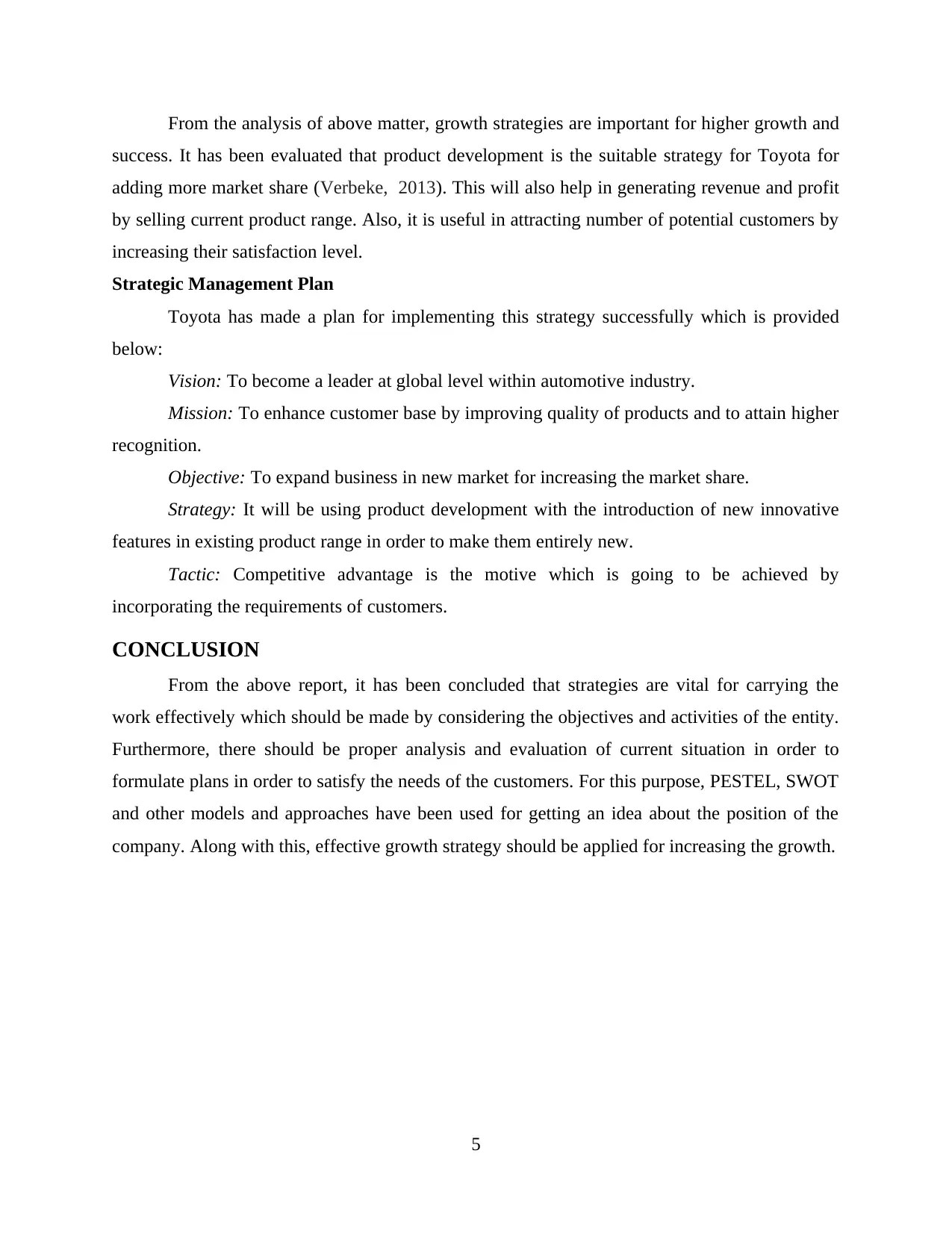
From the analysis of above matter, growth strategies are important for higher growth and
success. It has been evaluated that product development is the suitable strategy for Toyota for
adding more market share (Verbeke, 2013). This will also help in generating revenue and profit
by selling current product range. Also, it is useful in attracting number of potential customers by
increasing their satisfaction level.
Strategic Management Plan
Toyota has made a plan for implementing this strategy successfully which is provided
below:
Vision: To become a leader at global level within automotive industry.
Mission: To enhance customer base by improving quality of products and to attain higher
recognition.
Objective: To expand business in new market for increasing the market share.
Strategy: It will be using product development with the introduction of new innovative
features in existing product range in order to make them entirely new.
Tactic: Competitive advantage is the motive which is going to be achieved by
incorporating the requirements of customers.
CONCLUSION
From the above report, it has been concluded that strategies are vital for carrying the
work effectively which should be made by considering the objectives and activities of the entity.
Furthermore, there should be proper analysis and evaluation of current situation in order to
formulate plans in order to satisfy the needs of the customers. For this purpose, PESTEL, SWOT
and other models and approaches have been used for getting an idea about the position of the
company. Along with this, effective growth strategy should be applied for increasing the growth.
5
success. It has been evaluated that product development is the suitable strategy for Toyota for
adding more market share (Verbeke, 2013). This will also help in generating revenue and profit
by selling current product range. Also, it is useful in attracting number of potential customers by
increasing their satisfaction level.
Strategic Management Plan
Toyota has made a plan for implementing this strategy successfully which is provided
below:
Vision: To become a leader at global level within automotive industry.
Mission: To enhance customer base by improving quality of products and to attain higher
recognition.
Objective: To expand business in new market for increasing the market share.
Strategy: It will be using product development with the introduction of new innovative
features in existing product range in order to make them entirely new.
Tactic: Competitive advantage is the motive which is going to be achieved by
incorporating the requirements of customers.
CONCLUSION
From the above report, it has been concluded that strategies are vital for carrying the
work effectively which should be made by considering the objectives and activities of the entity.
Furthermore, there should be proper analysis and evaluation of current situation in order to
formulate plans in order to satisfy the needs of the customers. For this purpose, PESTEL, SWOT
and other models and approaches have been used for getting an idea about the position of the
company. Along with this, effective growth strategy should be applied for increasing the growth.
5
Paraphrase This Document
Need a fresh take? Get an instant paraphrase of this document with our AI Paraphraser
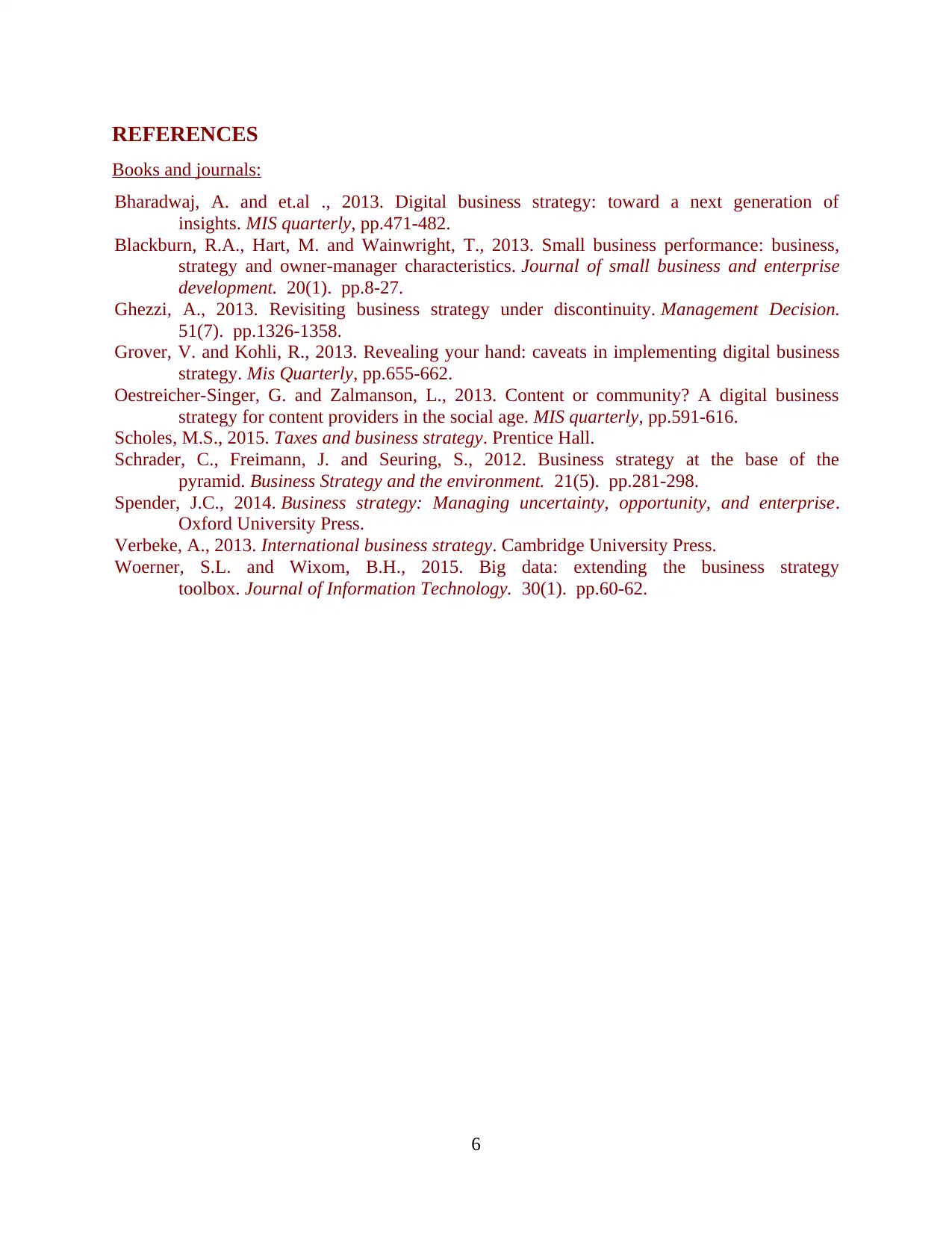
REFERENCES
Books and journals:
Bharadwaj, A. and et.al ., 2013. Digital business strategy: toward a next generation of
insights. MIS quarterly, pp.471-482.
Blackburn, R.A., Hart, M. and Wainwright, T., 2013. Small business performance: business,
strategy and owner-manager characteristics. Journal of small business and enterprise
development. 20(1). pp.8-27.
Ghezzi, A., 2013. Revisiting business strategy under discontinuity. Management Decision.
51(7). pp.1326-1358.
Grover, V. and Kohli, R., 2013. Revealing your hand: caveats in implementing digital business
strategy. Mis Quarterly, pp.655-662.
Oestreicher-Singer, G. and Zalmanson, L., 2013. Content or community? A digital business
strategy for content providers in the social age. MIS quarterly, pp.591-616.
Scholes, M.S., 2015. Taxes and business strategy. Prentice Hall.
Schrader, C., Freimann, J. and Seuring, S., 2012. Business strategy at the base of the
pyramid. Business Strategy and the environment. 21(5). pp.281-298.
Spender, J.C., 2014. Business strategy: Managing uncertainty, opportunity, and enterprise.
Oxford University Press.
Verbeke, A., 2013. International business strategy. Cambridge University Press.
Woerner, S.L. and Wixom, B.H., 2015. Big data: extending the business strategy
toolbox. Journal of Information Technology. 30(1). pp.60-62.
6
Books and journals:
Bharadwaj, A. and et.al ., 2013. Digital business strategy: toward a next generation of
insights. MIS quarterly, pp.471-482.
Blackburn, R.A., Hart, M. and Wainwright, T., 2013. Small business performance: business,
strategy and owner-manager characteristics. Journal of small business and enterprise
development. 20(1). pp.8-27.
Ghezzi, A., 2013. Revisiting business strategy under discontinuity. Management Decision.
51(7). pp.1326-1358.
Grover, V. and Kohli, R., 2013. Revealing your hand: caveats in implementing digital business
strategy. Mis Quarterly, pp.655-662.
Oestreicher-Singer, G. and Zalmanson, L., 2013. Content or community? A digital business
strategy for content providers in the social age. MIS quarterly, pp.591-616.
Scholes, M.S., 2015. Taxes and business strategy. Prentice Hall.
Schrader, C., Freimann, J. and Seuring, S., 2012. Business strategy at the base of the
pyramid. Business Strategy and the environment. 21(5). pp.281-298.
Spender, J.C., 2014. Business strategy: Managing uncertainty, opportunity, and enterprise.
Oxford University Press.
Verbeke, A., 2013. International business strategy. Cambridge University Press.
Woerner, S.L. and Wixom, B.H., 2015. Big data: extending the business strategy
toolbox. Journal of Information Technology. 30(1). pp.60-62.
6
1 out of 8
Related Documents
Your All-in-One AI-Powered Toolkit for Academic Success.
+13062052269
info@desklib.com
Available 24*7 on WhatsApp / Email
![[object Object]](/_next/static/media/star-bottom.7253800d.svg)
Unlock your academic potential
Copyright © 2020–2025 A2Z Services. All Rights Reserved. Developed and managed by ZUCOL.




